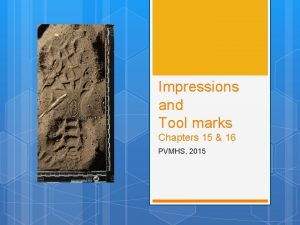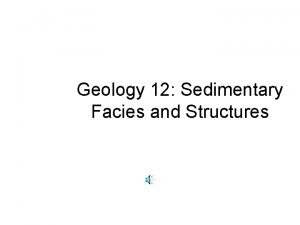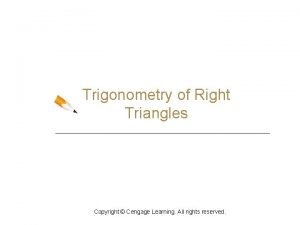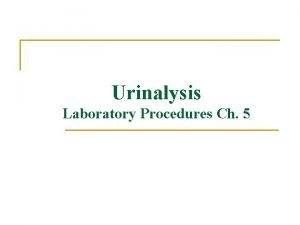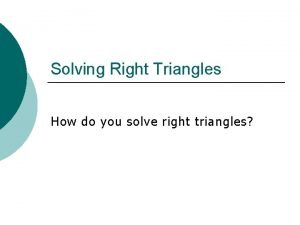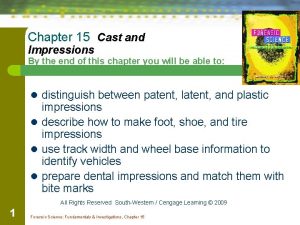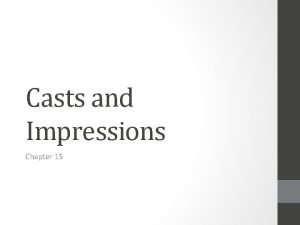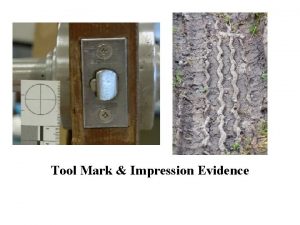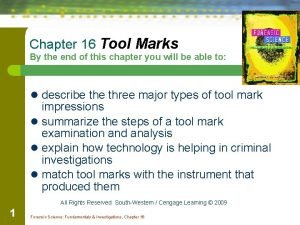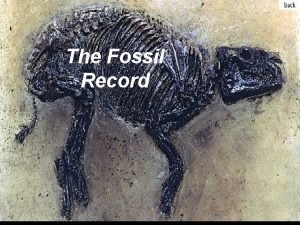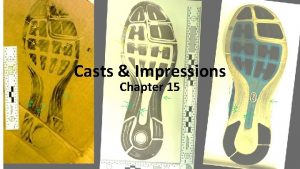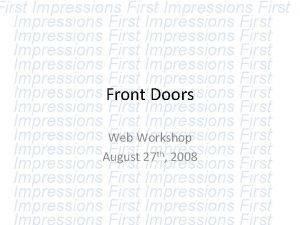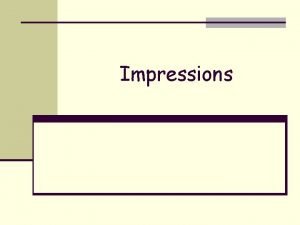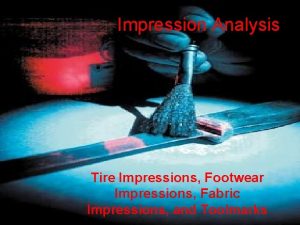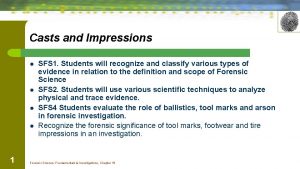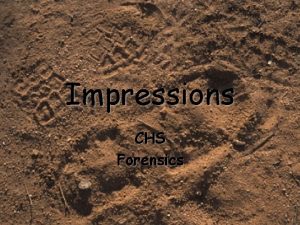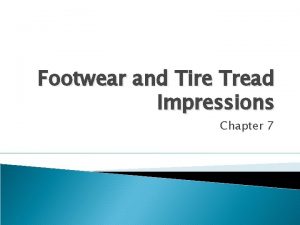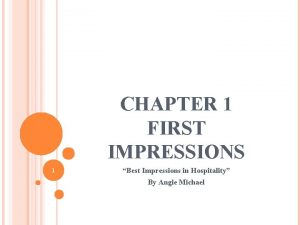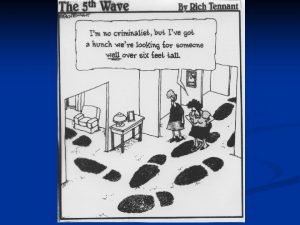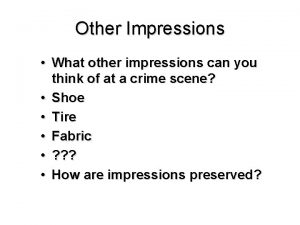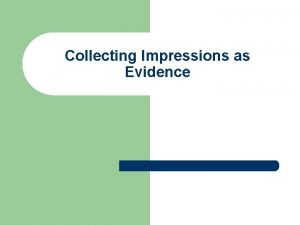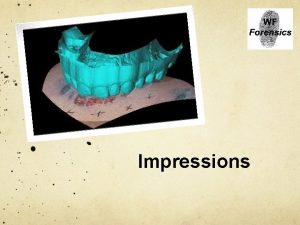Casts and Impressions Chapter 15 Types of impressions






















- Slides: 22

Casts and Impressions Chapter 15

Types of impressions • Patent impressions – visible, 2 -dimensional impressions produced when an object moves through soil, dust, paint, blood, or other fine particles and leaves a trace • Latent impressions – hidden to the eye but can be visualized through the use of special dusting & electrostatic techniques or chemical developers. Oils, fine soil, & other minute debris can be carried onto a floor & transferred. Even clean shoes or feet can transfer materials onto newly waxed/polished floors

Types of impressions • Plastic impressions – 3 -dimensional imprints left in soft materials, such as snow, mud, soil, or soap. Easily lost

Individual or class evidence? Class Evidence Individual Evidence • Tread patterns in shoes or tires can identify brands and size unless • Tread patterns in shoes or tires with specific marks or scuffs on them. • Dental impressions are individual evidence

Shoe impressions- shoe wear patterns • how a person walks wears specific patters into the soles of their shoes. Some factors that personalize shoes are: • Whether the person walks on their heels or toes • Body weight • Direction a person’s toes point – straight, inward, or outward • Shape of the foot • A person’s activities • Surface that a person usually walks on • Unique holes, cuts, or debris that can be embedded in the shoe

Gait and tracks • Gait – walking habits • A limp or injury creates an asymmetrical gait – 1 foot is angled or makes a deeper impression than the other • Someone carry a heavy weight

Gait and tracks • Tracks – indicate if a person is running or walking by the length of stride and pressure and shape of the impression • Can also tell: • # people @ crime scene • Movements of individuals @ crime scene • Entrance & exit to crime scene

Collection of shoe impression evidence • Photograph impressions from multiple angles, use identifying labels & rulers, & good lighting • Lift latent prints • Luminol for bloody prints • Dusting with fingerprint dust • Electrostatic lifting – used on paper, flooring, carpeting, wood, linoleum, asphalt, and concrete • Gel lifting – used on oily or moist impressions • Casting plastic impression – using plaster or dental stone

Tire treads & impressions – anatomy of a tire Purpose - to channel water away & to provide traction as it makes contact with the pavement Width & angle of grooves are engineered for different surfaces. - touring tires – small grooves to channel water @ high speeds - off-road tires – wide grooves for traction in mud

Recording tire tread impressions • Ridges & grooves are counted across the entire width of the tire • Unique characteristics such as wear or pebbles embedded in the grooves are noted • A tire impression involves 1 full rotation of the tire

Identifying a vehicle • Tire impressions can identify the make and model of a vehicle @ a crime scene. • Some identifying characteristics • Front and rear track width – center of 1 tire to the center of the opposite tire

Identifying a vehicle • Some identifying characteristics • Wheelbase – distance from the center of the front axle to the center of the rear axle

Identifying a vehicle • Some identifying characteristics • Turning diameter – measure of how tight a circle can be driven or minimal space required to make a U turn. • The larger the wheelbase, the larger the turning diameter

Establishing Car Movements from Tire tracks • A vehicle’s direction of travel can be determined from… • Vegetation disturbed as vehicle entered or left the road • Debris patterns cast off by a moving car • Splash patterns • Substance transfer (Ex. Oil leaking from vehicle to pavement) • Tire marks left

Accident reconstruction – 3 types of tire marks • Skid marks – formed when someone brakes suddenly & locks the wheels • Shows distance the breaks were applied • Used in calculating speed of the vehicle

Accident reconstruction – 3 types of tire marks • Yaw marks – produced when a vehicle travels in a curved path faster than it can handle & it skids sideways • Tires and road surface melt from extreme temperatures • Audible squeal & often smoke occurs

Accident reconstruction – 3 types of tire marks • Tire scrub – produced by damaged or overloaded tire(s) during or immediately after impact • Usually curved, irregular in width • May have striations, look like stripes • Determine area of impact

Dental impressions – individual evidence

Dental impressions – tooth structure

Dental Patterns – factors affecting dental impressions • • • # of teeth / missing teeth Color of teeth Size of teeth Alignment and distance between teeth Unique fillings, crowns, or caps Overall condition of teeth (broken / chipped teeth, teeth that have been ground down, etc.

Bite mark comparisons • May have up to 76 points of comparison • Dental chipping • Surface indentions • Distances between teeth • Alignment of teeth • Angle of mouth arch • Absence of teeth • Bite marks should be photographed with a ruler included asap! • Bite marks should be swabbed for DNA (in the saliva)

 Trooper
Trooper Cast types
Cast types Casts in urine
Casts in urine Urine casts images
Urine casts images Flute casts flow direction
Flute casts flow direction The chestnut casts his flambeaux
The chestnut casts his flambeaux Example of six trigonometric ratios
Example of six trigonometric ratios Casts in urine
Casts in urine Azotemia
Azotemia Renal tubule epithelial cells in urine
Renal tubule epithelial cells in urine There is no fear in love
There is no fear in love Kind of triangle
Kind of triangle Trig application word problems
Trig application word problems There are two basic types of impressions patent and latent
There are two basic types of impressions patent and latent Chapter 15 firearms toolmarks and impressions
Chapter 15 firearms toolmarks and impressions Chapter 15 firearms toolmarks and impressions
Chapter 15 firearms toolmarks and impressions Types of tire marks
Types of tire marks Types of impression evidence
Types of impression evidence Marks that are made when surfaces slide across one another.
Marks that are made when surfaces slide across one another. Evidence of evolution of remnants and impressions *
Evidence of evolution of remnants and impressions * Impression vocabulary
Impression vocabulary Examples of dominant impressions
Examples of dominant impressions Ma vision du métier observé
Ma vision du métier observé
